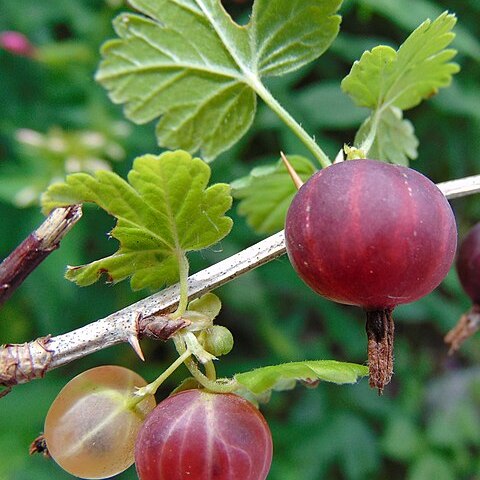Plants 0.5-1.5 m. Stems erect to sprawling, glabrous or pubescent, glabrescent; spines at nodes absent or 1-3, 3-8 mm; prickles on internodes absent, sometimes present, scattered. Leaves: petiole 0.7-1.5(-2) cm, pilose; blade roundish to rhombic, 5-7-lobed, cleft nearly 1/2 to midrib, 1-2.5 cm, base broadly cuneate to truncate, surfaces softly pubescent to glabrous, not glandular, lobes cuneate, long-deltate, margins toothed, apex broadly acute. Inflorescences pendent, solitary flowers or 2-3-flowered corymbs, 0.5-1.5 cm, axis glabrous or sparsely pilose. Pedicels not jointed, 2-5 mm, glabrous; bracts ovate to deltate, 1-2 mm, villous-ciliate with simple hairs. Flowers: hypanthium greenish white, obconic to campanulate, 2-3 mm, glabrous or pilose to densely pilose; sepals not overlapping, erect, recurved in age, greenish white or with purplish tinge along margins, broadly oblong, 3-4 mm; petals connivent, erect, white to purple tinged, spatulate-obovate, not conspicuously revolute or inrolled, 1.7-2.5 mm; nectary disc not prominent; stamens 2 times as long as petals; filaments linear, 3-4.5 mm, glabrous; anthers cream, oval, 0.2-0.3 mm, apex rounded; ovary glabrous; styles connate to middle, 3-4.5 mm, villous in proximal 1/2. Berries palatable, greenish to purplish, globose, 6-7 mm, glabrous. 2n = 16.
More
Much like no. 5 [Ribes oxyacanthoides L.] , and not always sharply distinct; nodal and internodal spines few and weak, or often absent; lvs softly hairy to glabrous, not glandular, often cuneate at base; bracts villous-ciliate; ovary and hypanthium often villous; fls slightly smaller; stamens and style ca twice as long as the pet, just equaling the sep; 2n=16. Rocky woods and cliffs; Nf. and Que. to Alta., s. to N.Y., Pa., n. Ind., ne. Ill., and Nebr. May, June. (R. huronense) Variable, and sometimes divided into several vars. on the basis of pubescence and lf-shape.
A shrub. It grows 1 m tall. The branches have bristles. The leaves are widely oval. They have 3-5 lobes. The base is a broad triangle shape. The flowers are green to purple and in groups of 3. They are narrowly bell shaped. The fruit are purple or black.
Rocky woods and cliffs, coastal thickets and heathlands, cedar and tamarack swamps, riverbottom forests, swales in sandhills, treed wetlands; at elevations up to 2,200 metres
More
It is a cool temperate plant. It suits hardiness zone 3.
The fruit are eaten raw, cooked or dried. They are used in jams, jellies, preserves, pies, tarts, and other desserts.

